Archons on Netflix? Gnostic Comsology and Stranger Things Indeed

 I maintain that John Lash’s opus Not in His Image (2006) is one of the best gnostic exegeses available—partly because he himself is able to “walk between worlds” and has a manifest “paranormal” skill set that allows him to merge and communicate with nature in ways that most people on earth could not even begin to fathom at this stage.
I maintain that John Lash’s opus Not in His Image (2006) is one of the best gnostic exegeses available—partly because he himself is able to “walk between worlds” and has a manifest “paranormal” skill set that allows him to merge and communicate with nature in ways that most people on earth could not even begin to fathom at this stage.
I draw the bulk of this material on the gnostic cosmology here from his excellent book.
The one caveat I offer for anyone who wants to read that fascinating book is that Lash then—like many people right now—seemed fairly bogged down in the gnostic rabbit hole instead of updating and modernising that paradigm from a meta-level, something, admittedly, very few people are doing a good job of (more on that elsewhere, particularly my coming second and third books - or check out my post THE SOUL TRAP PSYOP for a teensy weensy taster).
In short, there are too many “Neo-Gnostics” on the bandwagon and not enough true metaphysicians with a 40,000 foot view of things.
Anyway, on to the article…
Gnostic Seers: What did they see?
The Gnostic telestai (plural: those who were aimed/goal-oriented) of centuries past were mostly pre-Christian seers initiated into the Mysteries (they were also known as the Sons of Seth).
Note: It’s actually difficult to even define precisely who or what was a “true Gnostic,” but that issue is largely beyond our scope here. Suffice it to say the term itself comes from Henry More (1614 - 1687),
who applied it to the religious groups referred to in ancient sources as gnostikoi (Greek: “those who have gnosis, or ‘knowledge’ ”). The Greek adjective gnostikos (“leading to knowledge” or “pertaining to knowledge”) was first used by Plato to describe the cognitive or intellectual dimension of learning, as opposed to the practical. By the 2nd century CE, however, the name gnostikoi had been adopted by various Christian groups)1
Sophia is the mythological name Gnostics gave centuries ago to the “goddess” intelligence that plunged into the earth eons ago, ensouling it via the galactic centre, as it were. The telestai were ritually able to commune psychically with the Sophianic intelligence, receiving visions and insights; “she” was perceived as a milky white light.
If Gaia is the planet, Sophia (a creative torrent of sound and light, AKA, information) is the Aeon who dreamed herself into the planet, becoming “trapped,” as it were. “She” is not the physical planet, to be clear, but more akin to the inner psychic life or interiority of it.
“Her” plunge into our local solar system created, according to the Gnostics, an unexpected glitch in the “matrix” which was the arising of inorganic AI type beings called Archons, from the Greek archaia, meaning “prior,” “first,” and “in the beginning.” (The root “a” indicates “first” or beginnings as far as I have gathered, being the first/prior/primal letter of the alphabet.)

Chief among the Archons was/is the Demiurge, Ialdaboath (pronounced as “yahl-duh-buy-ot”), who mistakenly believes he is the creator of all he surveys. This deluded “god” (equated with the Christian Yahweh by some—another can of worms!) constructs his celestial home from residual/inert atomic matter, this being the planetary system we inhabit, though not including the sun, moon, and earth (the trinary “organic” system in Gnostic thought).
I will return to the concept and identity of Ialdaboath elsewhere, because it really needs it own deeper excavation.
The Archons can be considered the primal cosmic elementals, as kabbalistic lore calls them, or thought-form entities, AKA egregorials.
These parasitical “mental creatures” inhabit a parallel reality not far removed from ours…
Spider Beings: Ialdaboath and the Mind Flayer
A seer friend informs me that the closest visual representation he has yet seen of what Ialdaboath would look like to us is the malevolent spider-like shadow-being in the popular Netflix show Stranger Things. He refers to these archon-like entities as “spider beings” - something others have encountered around the world.
Interestingly, in this show, the being—known both as the Mind Flayer and the Shadow Monster—exists in its own parallel dimension (which the children dub the Upside Down—a Dungeons and Dragons reference).
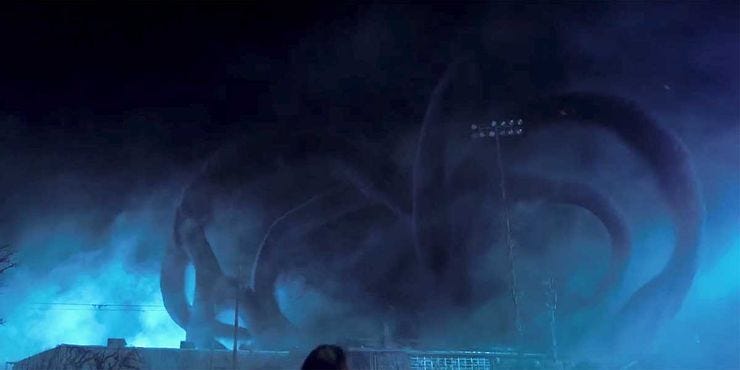
From its own parallel reality it is constantly trying to break through to ours, first, by invading people’s minds, taking them over (possessing them), and controlling their thoughts, perceptions, words, and actions, exactly as we would expect an Archon to do.
It feeds, like the Archons, on rage, pain and suffering (human emotion), at one stage building a grotesque body for itself out of thousands of dissolved rats—which, my friend sagely observes, are a species that has suffered greatly at the hands of humans through scientific experimentation, for example.
Thus, it is literally built out of collective animalistic pain and suffering, an allusion to the mammalian limbic system in the human brain where emotion (and trauma) registers.
Ultimately, in Season 3’s climax, the Mind Flayer succeeds in building an even bigger body out of its infected human hosts (not rats this time) by drawing them to its lair in the dark basement of an impersonal abandoned shed/warehouse (representing the fear, alienation, and general darkness of our post-industrial age, among other things).
It dissolves them from the inside out, congealing from their cellular goop a humongous repulsive body somewhat reminiscent of a giant spider—a creature that has long inspired fear in humans.

Thus, the pseudo-Ialdaboath draws its legions of psionically infected (possessed), unconscious zombies into the dark and empty industrial bowels of fear and isolation where—full of hatred for mankind (the Anthropos)—it builds a body out of the aggregate unconsciousness and self-loathing of its mindless drones.
Its singular obsessive purpose is to seek out and physically destroy the one being who stands in the way of its agenda to consume and control: El (a contraction and adaptation of Eleven, which was the only name she had prior to escaping captivity; the homophone elle is also the French pronoun meaning “she”).
Historically, mobs in the grip of the unconscious have a curious need to destroy the “Other” when the Other is seen as threatening their control or way of life, merely by being different—and nothing much has changed.
El is a young girl with enormous psi capabilities, including remote viewing and psychokinesis; she has suffered ongoing trauma at the hands of scientists experimenting on her at Hawkins National Laboratory where she was held captive and raised, a metaphorical lab rat deprived of a normal childhood.
The unconscious, it could be said, is locked in a perpetual tussle with the conscious, seeking any opportunity to overwhelm, beguile, hypnotise, and dominate. In El, the Archontic Demiurge (Mind Flayer) meets its match in the form of the Innocent, a child named after the master number eleven, which signifies highly developed intuition/psi among other things.
El(even) is a seer with immunity to the Archontic mind virus—she sees the dark illusionist for what it is. The Mind Flayer/Ialdaboath knows it can’t overtake or possess her mind, it can only hope to destroy her—and if it fails it risks extermination at her reluctant (but powerfully magical) hands. She is also the Mage (specifically shaman), in Jungian terms.
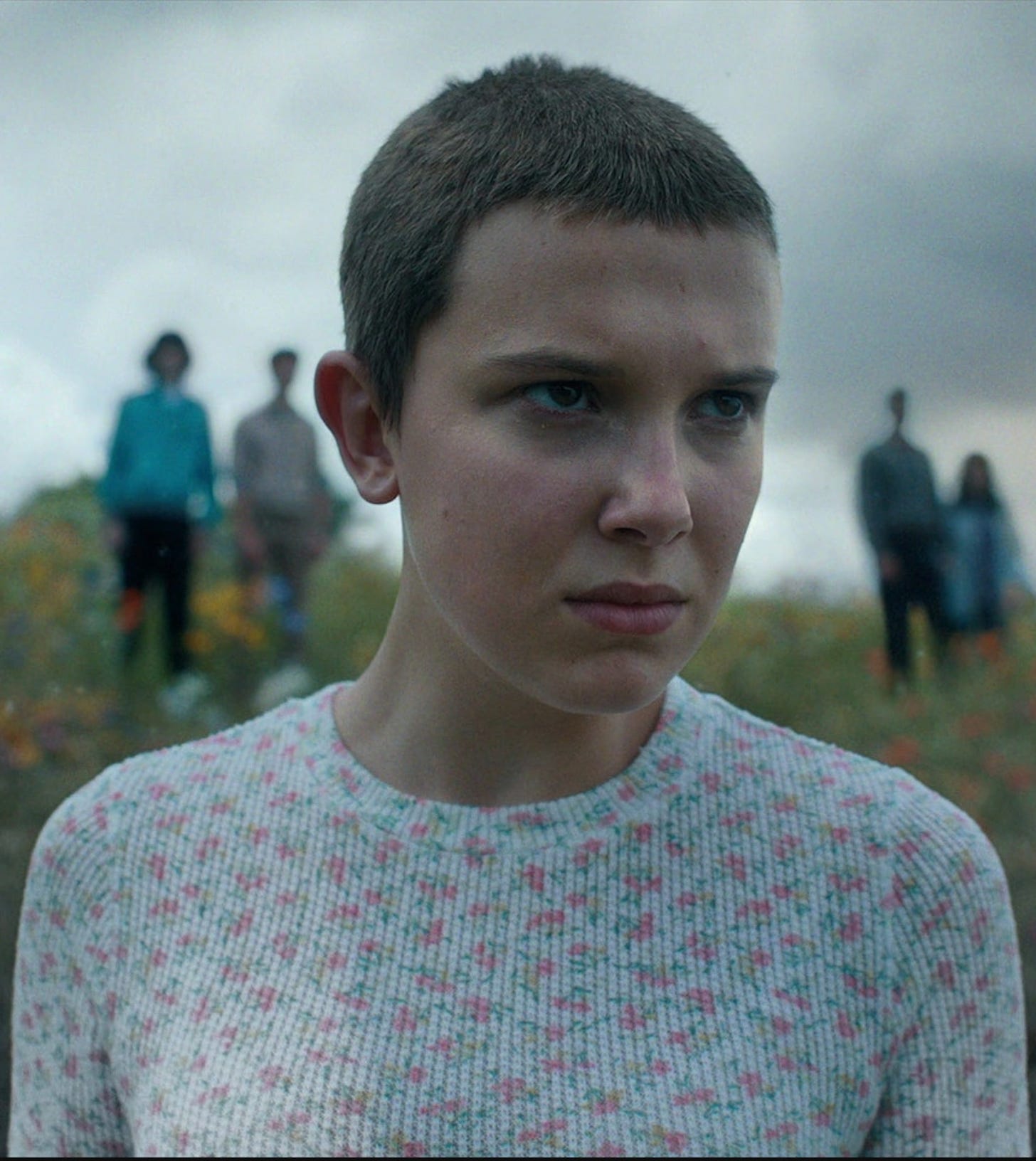
Un-blinded and unique, El is the fly in the shadow monster’s ointment of domination; an incandescent spark of consciousness standing against the vast and dark tyranny of the shadow (particularly including the trauma in the collective unconscious). She sees past superficial appearances and through the glamours of the Mind Flayer—“she” is conscious, and thus immune to its psychic vampirism.
The embodiment of vision, El’s seership and in-sight (inner sight) is crucial to healing the inner wounded child.
The Restoration of Innocence
There is a beautiful moment in the show’s adrenaline-pumping pivotal scene in Season 3 where she mentally ventures into the tormented mind of the flayed proxy Billy, the neighbourhood rebel and bully—and older adoptive brother of Max, El’s friend.
Billy, not coincidentally, is traumatised and full of rage, and hence, an ideal target for the Mind Flayer from the start.
Operating as a possessed drone of the Mind Flayer’s, Billy has a weakened El pinned to the floor as the grotesque behemoth looms, looking to finish her off. Scanning Billy’s mind in desperation, El retrieves a precious long-forgotten childhood memory—a moment of pure youthful innocence shared with his now-deceased mother at the beach:
“…You ran to her on the beach…There were seagulls. She wore a hat with a blue ribbon; a long dress with a blue-and-red flower; yellow sandals—covered in sand. She was pretty…And you were happy.”
The recounting of this snaps Billy out of his hypnotic trance and breaks the pseudo-Ialdaboath’s psionic grip on him.

The remembrance and integration of this submerged and fragmented part of himself re-minds Billy of his humanity; reconnected to the innocence of his inner child and his humanity, he rises to his feet and faces the Shadow Monster head-on—the demonic Flayer no longer has him in thrall; he is no more a mere vector for the mind virus of hatred and domination, having touched an ancient spark of love—the love of and for his mother—still alive in his core.
Billy’s final act is that of noble and voluntary self-immolation: he faces the Mind Flayer defiantly and surrenders to the violence of the shadow, using himself as a human shield, allowing the monster to destroy him physically (but not spiritually), buying El and friends precious seconds.

It is seemingly only delaying the inevitable, but ultimately not in vain, since the group is saved when the Mind Flayer’s dimensional portal is closed and its connection to the Upside Down (the Archontic “flatland”) severed, killing it just as it bares down on El and company who have no escape and no more tricks up their sleeves.
Billy’s absolution and redemption is in sacrificing his own life to protect human vision, innocence, consciousness, and free will from all-consuming fear, darkness, and tyranny—the destruction of the unrestrained and disowned shadow.
The integration of his own shadow material is his salvation from a fate worse than death: being harvested by the Mind Flayer and dying unconsciously under the hypnotic spell of the tyrannical and beguiling shadow.
The scene is reminiscent of Neo’s final act of self-sacrifice in the Matrix, as he allows the machines to plug into him and re-upload his consciousness back into the Matrix, in exchange for a truce between humans and AI. Archons are regarded as a form of “artificial intelligence,” as it happens.
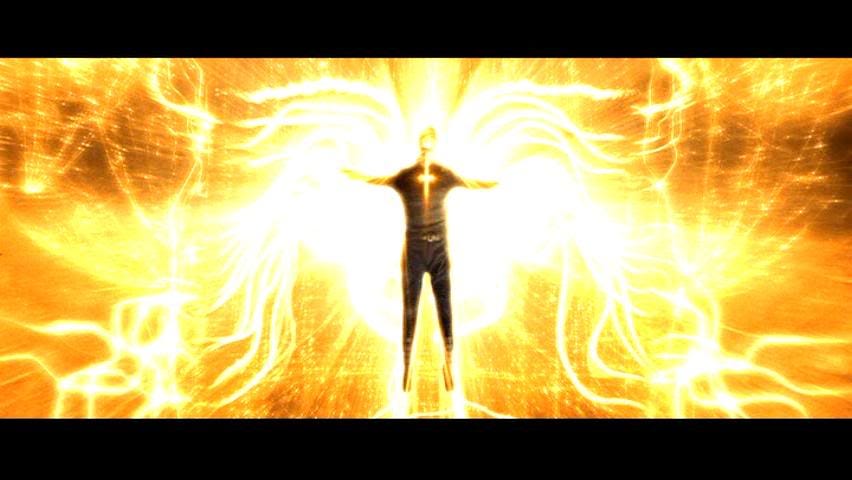
El / Eleven / 11 / Elle
Eleven (11) is a doubling of one (1), with 1 representing both new beginnings and purity. El/Eleven has no hidden agendas, no desire to harm anyone, and just wants to be done with the unfolding chaos. The Shadow Monster is rage, fear, pain, and malice itself and, like the mind virus playing out in humankind, seeks only to replicate and dominate. (You could call it wetiko.)
El is a singularity, pure and untarnished, while the Mind Flayer is the polar opposite, an aggregation of somnambulant humanity’s fear, trauma, pain, and malice; after infecting a host, the Mind Flayer/Ialdaboath has them in a sort of mindless waking trance—a good description of swaths of humanity at the moment unfortunately, who unwittingly infest themselves further with the Archontic virus every day (particularly via the mass media which spews forth the mass-mind-control programme set by the Ultra-rich who control politics and the media-pharma-industrial complex).
Also worthy of note is that the prefix El (from elohim) denotes the highest divinities of the ancient Hebrew and Canaanite peoples:
Elohim occurs frequently throughout the Torah. In some cases (e.g. Exodus 3:4, "Elohim called unto him out of the midst of the bush ..."), it behaves like a singular noun in Hebrew grammar, and is then generally understood to denote the single God of Israel. In other cases, Elohim acts as an ordinary plural of the word Eloah, and refers to the polytheistic notion of multiple gods (for example, Exodus 20:3, "You shall have no other gods before me").2
El does indeed have god-like psi powers.
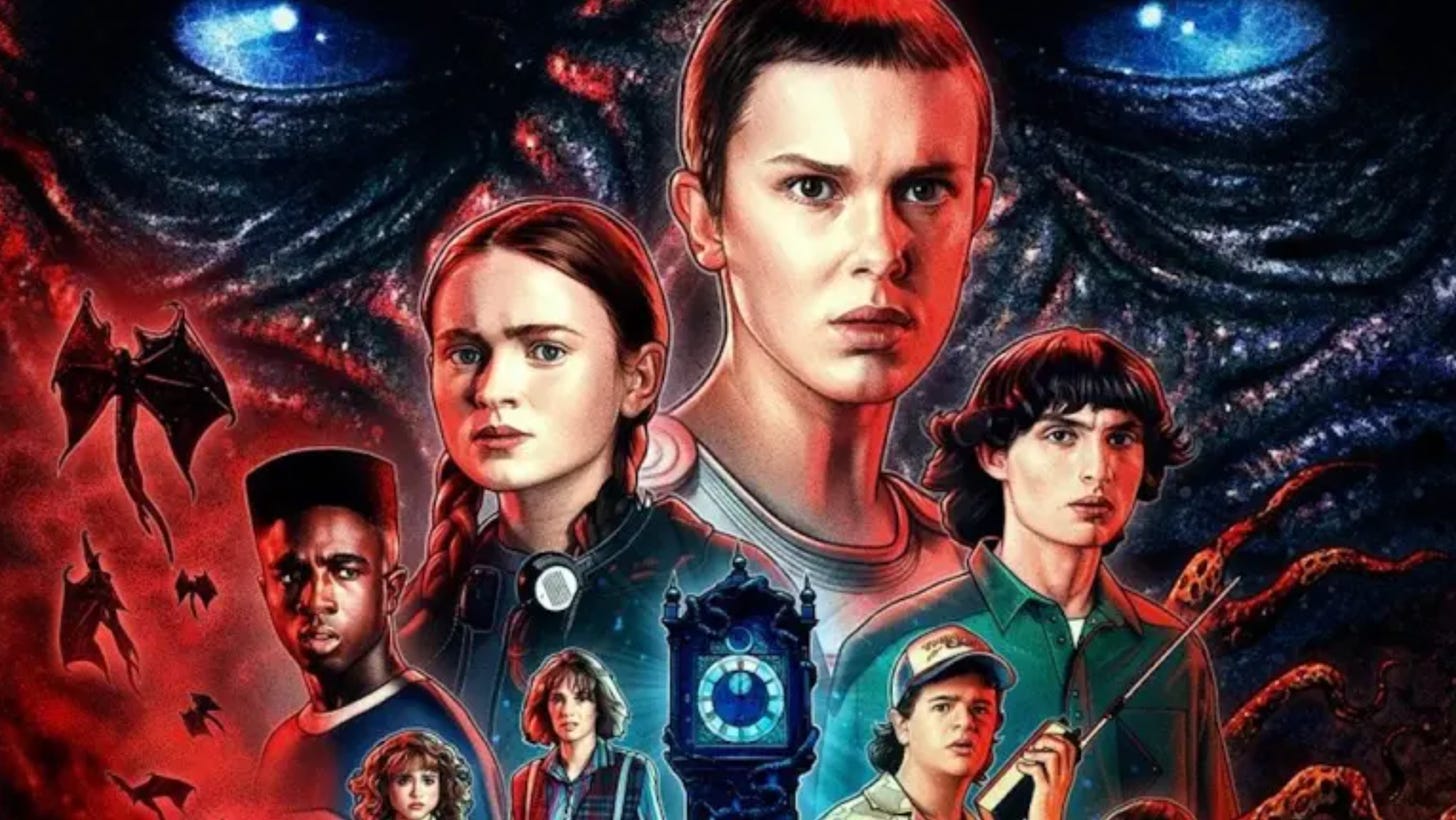
The Archontic Mind Virus
Left in unconsciousness or repression, the Shadow Monster spreads its Archontic virus unchecked; “seership,” or vision—the process of self-reflection, introspection, and alchemical integration of our shadow—is the antidote to its reign of terror.
We need to see with the mind of El-even (11), with innocence and clair-vision, to create a new beginning both personally and collectively; by facing the darkness/dark night we gain the chance to become the “hero” and be born anew, empowered as never before.
I find it interesting that the Mind Flayer creates forms for itself that mimic life and ape it, but it cannot—like the Archontic demiurge it represents—truly create/emanate the way that the Pleromic Aeons can, being that they are deeply connected to the All and are direct emanations from the galactic centre and ultimately the Pleroma.
Like Ialdaboath, the Shadow Monster of Stranger Things creates pseudo-lifeforms out of “dead” matter (it literally dissolved and re-constituted bodies of the dead, be they human or rat); simulacra lacking nous and true creativity.
The Demiurge is “lord and master” of the Kenoma, the inorganic “dead” celestial matter of outer chaos—or so it thinks. (From another angle, the Kenoma is also considered to be our illusory material world in general, similar to the Vedantic concept of maya, the world of appearances.)
Ialdaboath’s and the Mind Flayer’s first and most primary form of manipulation is not of matter but of minds which it seeks to invade and control (flay). From there, a surrogate manipulation of matter can occur via infected hosts, exactly as depicted in Stranger Things. Lacking true creative agency, the Mind Flayer is a parasite of the highest order, and a psychic rapist of sorts.
It can hijack, infect, and co-opt, but—unlike its human targets and proxies—is bereft of true creativity.
It is not truly “alive” as we think of it, rather, it is much nearer an actual embodiment of death and entropy.
The first and habitual targets of the Mind Flayer are the children as they, in their innocence and purity—with vision, courage, innocence, and integrity in tact—pose its greatest threat to dominating humanity through the collective reservoir of unresolved trauma and pain.
Hence young Will the “Wizard” (his D&D character)—an incipient medium-shaman with one foot in the human world and one foot in the Upside Down/Archontic reality—being an initial target of the Mind Flayer.
Will, “channels the monster,” so to speak, albeit reluctantly.
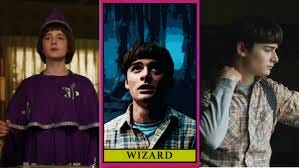
He and his friends—who come to include Eleven as the group’s resident oracle and protectress—must synergistically collaborate and thwart the Mind Flayer’s attempts to destroy them, and take over the entire human biosphere with its tyrannical control and enforcement of a homogenous zombie-like unconsciousness.
Collectively, El and friends embody the archetypes and traits of innocence, magic, vision/seership, will, courage, and the unmatched power of a group focused on their mission operating in harmony against the seemingly insurmountable power of the shadow and the seductive, hypnotic illusions of the collective unconscious.
We will need all of these to move forward together and prevent the globalist’s Archontic agenda of total technocratic control (now branded as “the Great Reset”, replete with eco-fascistic “15-minute cities”) from eventuating. It is absolutely possible.
We only need to choose.
Face the shadow—or let it rule us through its barely human, unconscious proxies.
This article is taken from a passage in Book 2 of THE GRAND ILLUSION by Brendan D. Murphy. Find Book 1 HERE


About Brendan:
Host of Truthiverse podcast. Author of the epic, “The Grand Illusion: A Synthesis of Science and Spirituality — Book 1.” Founder of The Truthiversity 📽
🚨 For the FULL article and access to ALL of my multimedia content, become a member of The Truthiversity today
Links:
🧬 Watch my free How to Evolve Yourself Masterclass to discover how I help people accelerate their healing, evolution, and self-mastery organically without hard work or meditation.
📲 Follow me on Telegram
https://www.britannica.com/topic/gnosticism
https://en.wikipedia.org/wiki/Elohim#:~:text=Elohim%20(Hebrew%3A%20%D7%90%D6%B1%D7%9C%D6%B9%D7%94%D6%B4%D7%99%D7%9D%2C%20romanized,always)%20the%20God%20of%20Israel.

